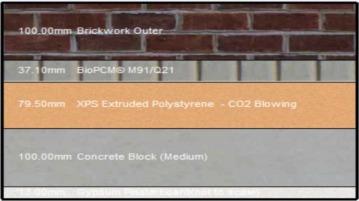当前位置:
X-MOL 学术
›
Energy Rep.
›
论文详情
Our official English website, www.x-mol.net, welcomes your feedback! (Note: you will need to create a separate account there.)
A comparative evaluation on energy consumption of a building using bio-based and paraffin-based phase change materials integrated to external building envelope
Energy Reports ( IF 5.2 ) Pub Date : 2024-03-29 , DOI: 10.1016/j.egyr.2024.03.041 Mohammad Hossein Jahangir , Reza Alimohamadi
Energy Reports ( IF 5.2 ) Pub Date : 2024-03-29 , DOI: 10.1016/j.egyr.2024.03.041 Mohammad Hossein Jahangir , Reza Alimohamadi

|
Using thermal energy storage such as phase change materials (PCMs) is a suitable solution to reduce energy consumption in order to maintain thermal comfort conditions inside the building. There is a wide range of phase change materials according to their different characteristics such as melting temperature, freezing temperature, latent heat capacity, specific heat value of solid and liquid phase, thermal conductivity coefficient, and charge and discharge range, which makes it difficult to choose the right PCM. In this research, two common groups of phase change materials that are used commercially are studied and after performing a sensitivity analysis on them, a suitable temperature range is selected. Then the selected PCMs are placed in different parts of the external envelopes of the building and various parameters such as air conditioning system energy consumption, thermal comfort, heat balance, etc. are examined. It should be noted that in this study, the use of PCMs in buildings with cooling and heating systems is investigated. In order to carry out the simulation, a two-story office building located in Arak, Iran was modeled in Design Builder software along with all the details. The outputs show that if Bio PCM is used in the outer layer of the wall in the summer season, it is possible to save up to 154 w/m2 in the energy required for cooling the building. While the use of Bio PCM M91 Q21 material in the inner layer of the wall will reduce the load of the cooling system by 246.15 Wh/m2. Also, if RT PCM is used, it is possible to reduce the heat load by 80%. Furthermore, by analyzing the optimal cases, it can be concluded that increasing the thickness of the PCM layer cannot effectively improve the thermal performance of the building. On the contrary, their reduction in some cases leads to a reduction in energy demand in the building. Finally, in order to generalize the results, the optimal situation was compared with two similar climates of Arak city.
中文翻译:

使用生物基和石蜡基相变材料集成到外部建筑围护结构的建筑能耗的比较评估
使用相变材料(PCM)等热能存储是减少能源消耗以维持建筑物内部热舒适条件的合适解决方案。相变材料根据其熔化温度、凝固温度、潜热容、固相比热值、液相比热值、导热系数、充放电范围等不同特性,其种类繁多,这使得相变材料的制备变得困难。选择正确的 PCM。在这项研究中,研究了商业上使用的两类常见的相变材料,并对它们进行灵敏度分析后,选择了合适的温度范围。然后将选定的PCM放置在建筑物外部围护结构的不同部分,并检查空调系统能耗、热舒适度、热平衡等各种参数。值得注意的是,在本研究中,研究了 PCM 在具有制冷和供暖系统的建筑物中的使用。为了进行模拟,在 Design Builder 软件中对位于伊朗阿拉克的一座两层办公楼以及所有细节进行了建模。输出结果表明,如果在夏季墙体外层使用 Bio PCM,则可以节省高达 154 w/m2 的建筑物冷却所需能量。而在内壁内层使用Bio PCM M91 Q21材料将使冷却系统的负荷减少246.15 Wh/m2。另外,如果使用RT PCM,则可以减少80%的热负荷。此外,通过对最佳案例的分析,可以得出结论:增加PCM层的厚度并不能有效提高建筑物的热工性能。相反,在某些情况下,它们的减少会导致建筑物的能源需求减少。最后,为了推广结果,将最佳情况与阿拉克市的两种类似气候进行了比较。
更新日期:2024-03-29
中文翻译:

使用生物基和石蜡基相变材料集成到外部建筑围护结构的建筑能耗的比较评估
使用相变材料(PCM)等热能存储是减少能源消耗以维持建筑物内部热舒适条件的合适解决方案。相变材料根据其熔化温度、凝固温度、潜热容、固相比热值、液相比热值、导热系数、充放电范围等不同特性,其种类繁多,这使得相变材料的制备变得困难。选择正确的 PCM。在这项研究中,研究了商业上使用的两类常见的相变材料,并对它们进行灵敏度分析后,选择了合适的温度范围。然后将选定的PCM放置在建筑物外部围护结构的不同部分,并检查空调系统能耗、热舒适度、热平衡等各种参数。值得注意的是,在本研究中,研究了 PCM 在具有制冷和供暖系统的建筑物中的使用。为了进行模拟,在 Design Builder 软件中对位于伊朗阿拉克的一座两层办公楼以及所有细节进行了建模。输出结果表明,如果在夏季墙体外层使用 Bio PCM,则可以节省高达 154 w/m2 的建筑物冷却所需能量。而在内壁内层使用Bio PCM M91 Q21材料将使冷却系统的负荷减少246.15 Wh/m2。另外,如果使用RT PCM,则可以减少80%的热负荷。此外,通过对最佳案例的分析,可以得出结论:增加PCM层的厚度并不能有效提高建筑物的热工性能。相反,在某些情况下,它们的减少会导致建筑物的能源需求减少。最后,为了推广结果,将最佳情况与阿拉克市的两种类似气候进行了比较。



























 京公网安备 11010802027423号
京公网安备 11010802027423号